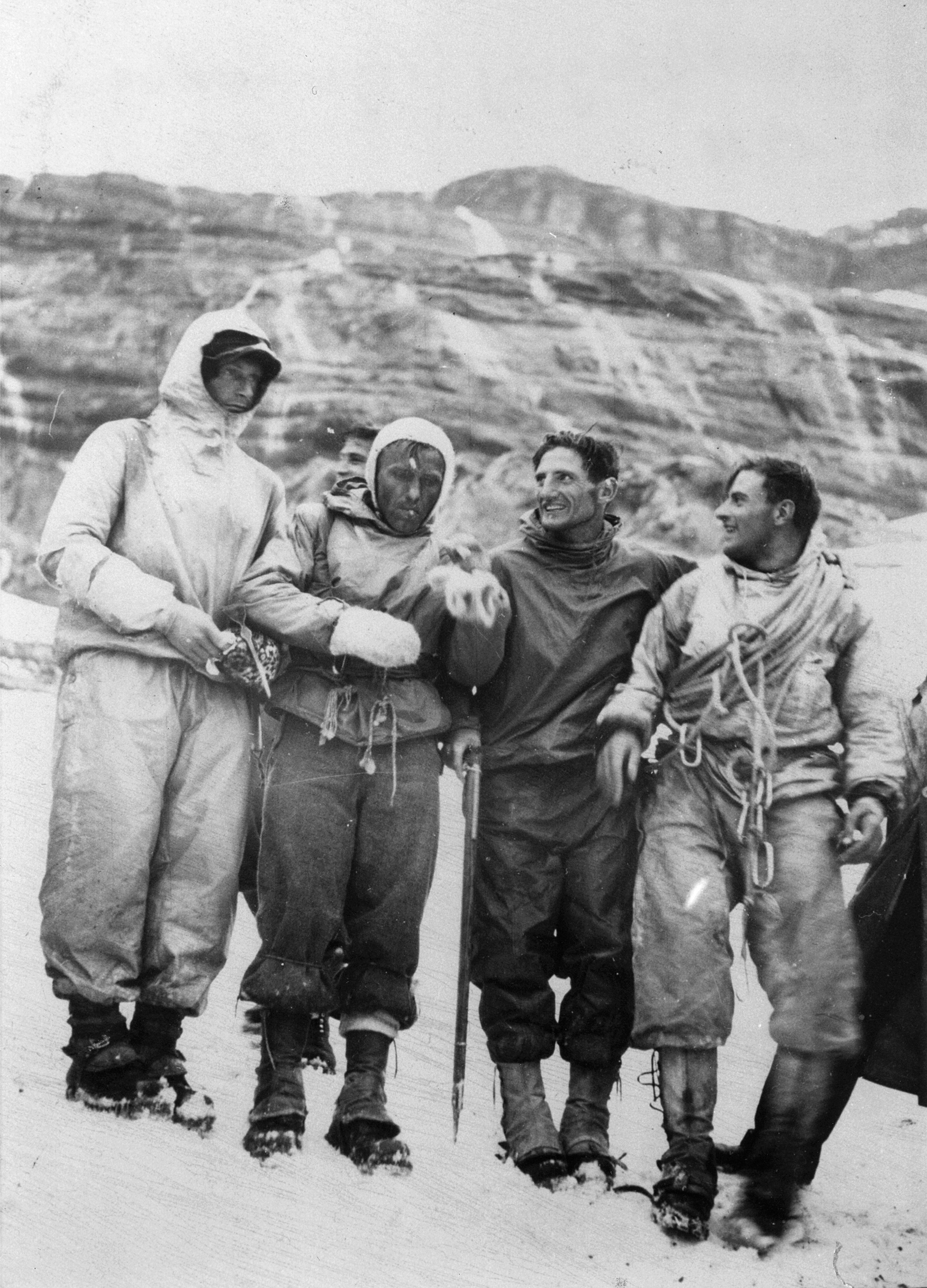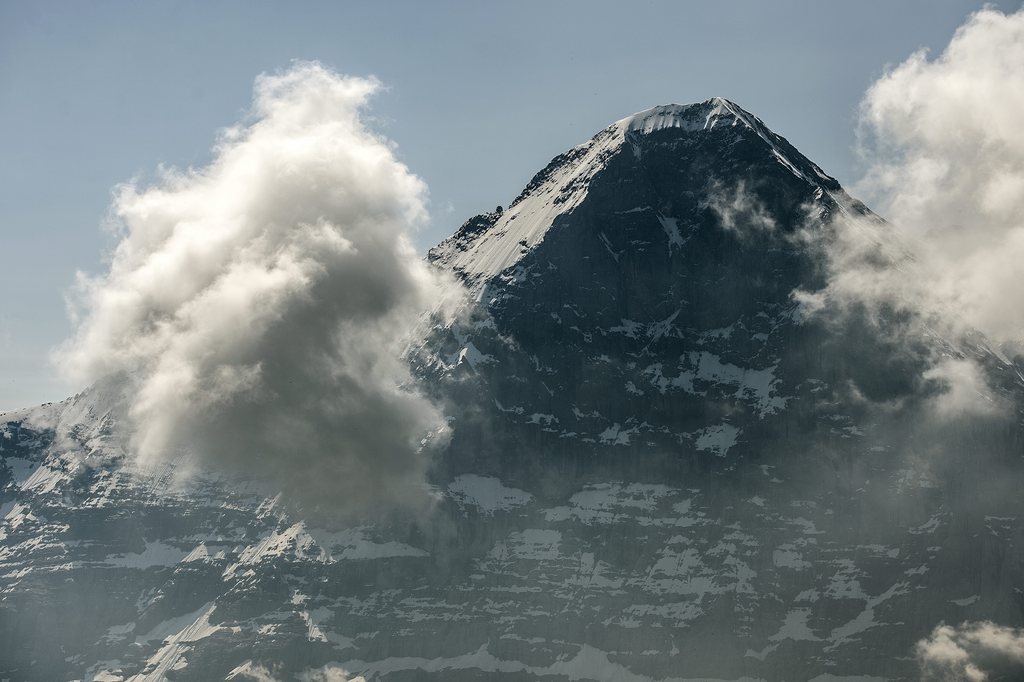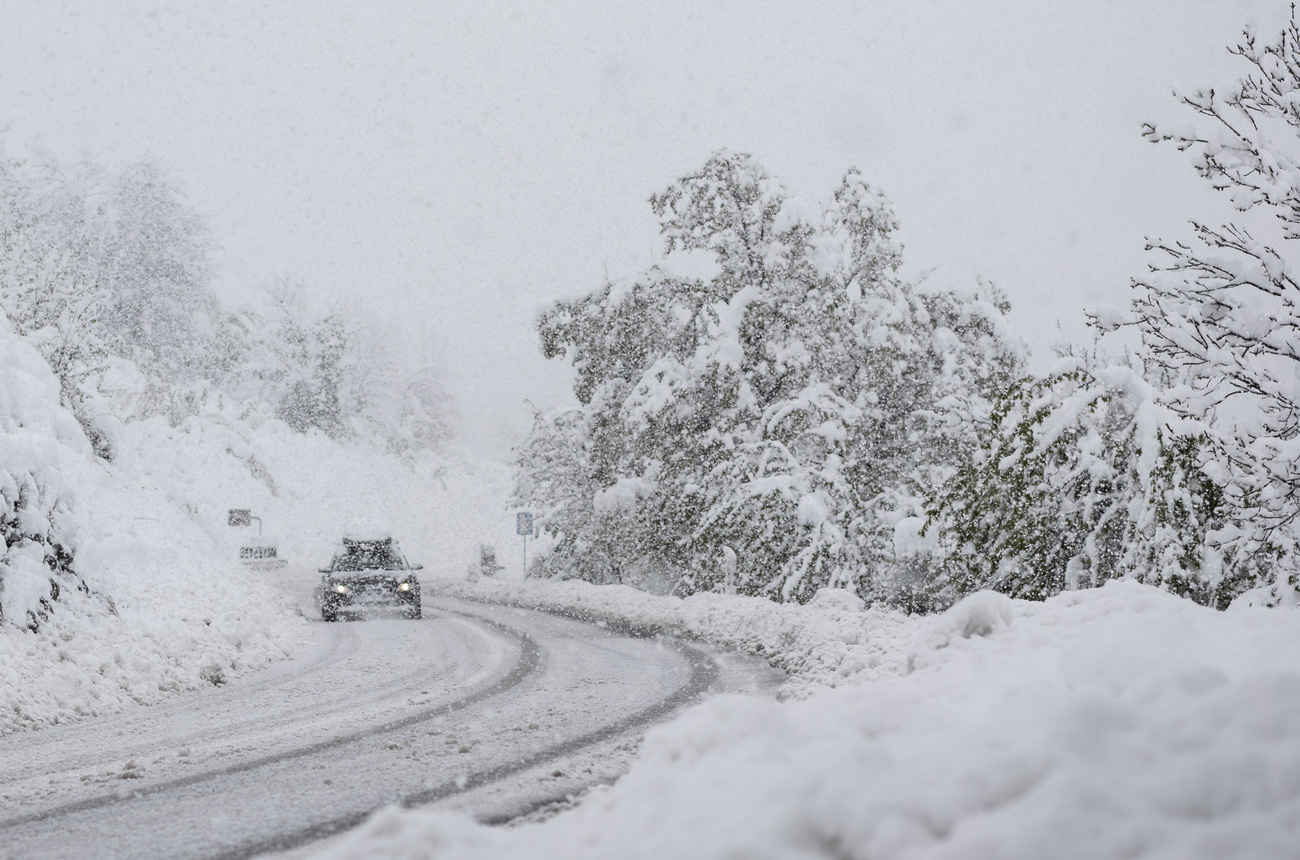Eiger continues to spark awe and fear

Seventy-five years ago, a quartet of German and Austrian climbers were the first to summit the Eiger by climbing its feared north face. swissinfo.ch gets an up-close impression of the “death wall” to find out why it continues to attract top alpinists and ordinary tourists.
As part of a group of journalists out for an easy summer hike to the foot of the north face, I find it hard to imagine how anyone could climb the vertical, 1,800m wall at all – never mind do it in a few hours.
Even this short walk isn’t without peril. Because the Eiger is always shedding, some parts of the trail are littered with chunks of limestone that wobble underfoot – a hazard if you’re distracted by scenery or conversation. At one point I have to claw my way over a slippery dune of melting snow, which leaves my fingertips smarting for several minutes.
Stubborn fog makes it hard to see the mountain properly, but it adds a touch of mystery to the mountain that has mesmerised people from around the world.
“How often is it like this?”, I ask Stephan Siegrist, an elite Swiss alpinist and mountain guide who has climbed the north face 29 times.
“Pretty often in summertime – clouds move up and they condense there – and you often have snowfall at that time. Hard to believe if you’re down here in the nice weather,” Siegrist says.
There was a dark side to the success of the German-Austrian team that first managed to summit the Eiger via its north face. Nazi leaders exploited the feat for their own propaganda purposes.
Austrian climber Heinrich Harrer joined the Nazi Party in 1938, when Germany took control of Austria. He was also a member of the SS, the party’s police wing associated with atrocities during the Second World War. He was cleared of any war crimes.
Harrer is also remembered for the years he spent with the young Dalai Lama after escaping from British custody in India and trekking to Tibet in 1944.
Remembering the past
In 2002, Siegrist and colleague Michal Pitelka did a re-enactment of the 1938 expedition using period-style clothing and equipment.
“The shoes were terribly heavy and painful,” he recalls, adding that the old-fashioned ropes they had to carry were also a burden.
Yet that was how Germans Anderl Heckmair and Ludwig Vörg, as well as Austrians Heinrich Harrer and Fritz Kasparek, managed to be the first to conquer the Eiger North Face exactly 75 years ago – after nine others had died trying. The expedition took them nearly four days and had its share of hairy moments, like avalanches and falls.
Since then, at least another 55 people have been killed trying to scale the 1,800-metre face of the “ogre” – a loose translation of Eiger. The mountain itself is 3,970 metres high.
One victim was American John Harlin II, whose rope severed at 1,300m in March 1966. He had been attempting to put up the first direttissima (most direct) on the face. His Scottish climbing partner as well as a team of four Germans managed to reach the summit on March 25 – a month after they’d set out. The new route was named after Harlin.
His son, John Harlin III, was just nine at the time, and the loss both haunted and inspired him. In 2005, he scaled the north face; the IMAX film “The Alps” tells the story of his quest. More recently, Harlin produced a multimedia blog for swissinfo.ch, Border Stories.

More
Recalling the first Eiger North Face rescue
“Everest of real climbers”
“The Eiger has always fascinated climbers the world over, and likely always will. It’s the biggest face in the Alps (and one of the biggest in the world) and the climbing is hard. But the Eiger’s reputation is at least as important as its size and difficulty,” Harlin told swissinfo.ch, referring to the deaths as well as the incredible stories of success and rescue efforts – such as the Toni Kurz tragedy in 1936 or the Claudio Corti drama in 1957 (see related gallery).
Harlin believes the Eiger’s reputation and history make every climber want to put himself among the legends.
“There are only a few iconic cliffs and mountains that we all want to experience. Most can only dream of doing the Eiger, but if you feel you have the skills and the courage, then you want to prove it to yourself. To me the Eiger is the Everest of real climbers,” Harlin says.
Siegrist’s appreciation of it is also high.
“It’s a big mountaineering adventure, and it’s always nice to climb here. We have a really great view of the landscape that makes it special, too,” says Siegrist, noting the contrast between the cold grey rock and the greenery of the countryside.
Popular appeal
As the president of the Grindelwald mountain guide association points out, all the chalets have been built to take in the view of the imposing rock face.
“If you’re in Grindelwald, the Eiger North Face is so present that it’s like looking in the mirror in the morning,” Fredi Abegglen told swissinfo.ch.
Johann Kaufmann, mountain guide and head of Grindelwald’s mountain sport school, adds, “It’s our USP. I’ve seen lots of mountains, but seldom such fascinating ones.”
Proof that the Eiger is a big attraction for non-climbers, is evidenced by the establishment nearly 30 years ago of a tourism office especially for Japanese visitors.
“They come not to climb themselves, but to see where Japanese climbers like Yuko Maki have been,” Yuri Ichikawa of the Japanese Information Bureau told swissinfo.ch. Maki was part of the four-man party that made the first ascent via the Mittellegi ridge (not via the north face) on September 10, 1921.
Popular culture has also influenced their travel plans.
“Japanese people have an image of Switzerland, and that’s Grindelwald,” Ichikawa said, explaining that the Japanese animation artists who created the “Heidi” cartoon had based their scenery on landmarks like the peaks of the Eiger, Mönch and Jungfrau, and the postcard Lauterbrunnen valley.
Like Heidi, I’m content to frolic in the foothills on gentle hiking trails – unencumbered by heavy gear and the fear of falling to my death. Yes, I prefer to admire the Eiger North Face on safe ground.

More
Not just a pretty north face
July 24, 1938: First ascent by a team of two Germans (Anderl Heckmair and Ludwig Vörg) and two Austrians (Heinrich Harrer and Fritz Kasparek) after three-and-a-half days of climbing.
March 12, 1961: First winter ascent by a team of four Germans.
August 3, 1963: Swiss Michel Darbellay makes the first solo ascent, completing the climb in 18 hours.
September 3, 1964: German Daisy Voog (with Werner Bittner) is the first woman to reach the summit via the face.
August 25, 1981: Swiss Ueli Bühler does it in 8 hours.
July 27, 1984: Austrian Thomas Bubendorfer reaches the summit, climbing without a rope, in 4 hours, 50 minutes.
March 9, 1992: Catherine Destivelle of France is the first woman to solo the face. It takes her 17 hours.
February 12, 2008: Swiss Ueli Steck sets a new record: 2 hours, 47 minutes.
April 20, 2011: Swiss Daniel Arnold improves on Steck’s time, completing the climb in 2 hours, 28 minutes.

In compliance with the JTI standards
More: SWI swissinfo.ch certified by the Journalism Trust Initiative









You can find an overview of ongoing debates with our journalists here . Please join us!
If you want to start a conversation about a topic raised in this article or want to report factual errors, email us at english@swissinfo.ch.